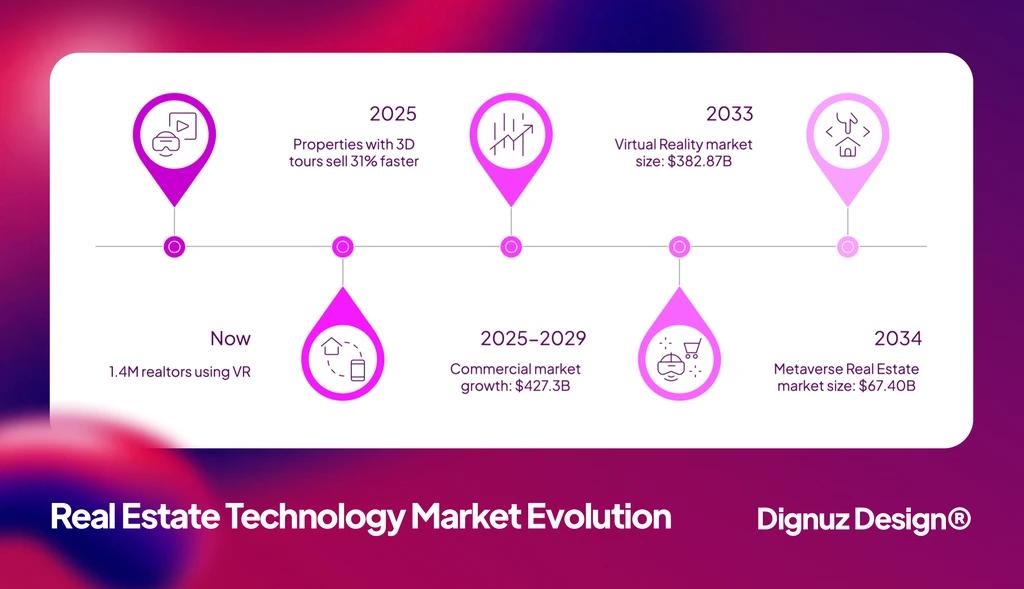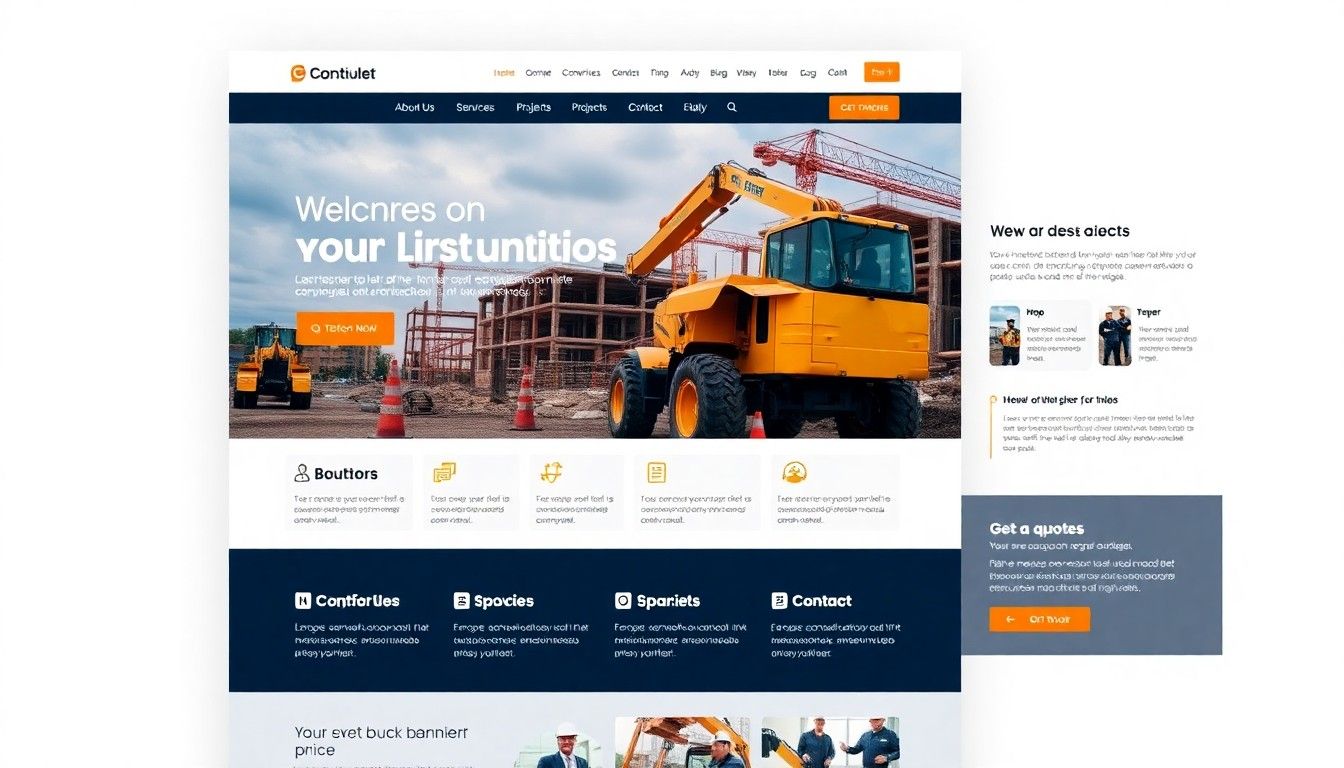How to Develop a Real Estate Web App That Stands Out in the Market

The real estate industry continues to embrace digital transformation. Modern property buyers expect intuitive online experiences. A well-designed real estate web app can set your business apart from competitors.
Today's real estate market demands more than basic listings. Buyers want immersive experiences before physical viewings. Sellers seek platforms that showcase properties effectively. Agencies need tools that streamline operations.
In this guide, we'll explore how to develop a real estate web app that truly stands out. We'll cover essential features, technology considerations, design principles, and implementation strategies. Let's build something remarkable.
Understanding the Real Estate Web App Market
The digital real estate market continues to expand rapidly. Understanding current trends helps developers create relevant solutions. Recent statistics reveal significant growth in technology adoption.
The virtual reality market in real estate shows impressive growth projections. The VR market is projected to reach $382.87B by 2033 with a CAGR of 27.3%. (Source: Virtual Reality Growth Trends Report)
Professional adoption rates show promising momentum. Goldman Sachs predicts that 1.4M realtors will use VR by 2025. (Source: Program-Ace)
The metaverse represents another frontier for real estate technology. The metaverse real estate market is expected to hit $67.40B by 2034, growing at a CAGR of 36.55%. (Source: Precedence Research)
Meanwhile, the traditional real estate sector maintains strong growth. The global commercial real estate market is forecast to grow by $427.3B between 2025-2029. (Source: Technavio)
These statistics highlight the significant investment in real estate technology. Developers who understand these trends can create web apps that align with market direction. A forward-thinking approach ensures your solution remains relevant.

Essential Features for a Standout Real Estate Web App
Creating a distinctive real estate web app requires careful feature selection. The right functionality enhances user experience while providing competitive advantages. Let's explore the must-have components.
Property Listing and Search Capabilities
Advanced search functionality forms the foundation of any real estate web app. Users need to find relevant properties quickly. Effective filtering options save time and improve satisfaction.
Your search system should include standard filters like location, price range, and property type. Beyond basics, consider adding neighborhood information, school districts, and transit scores. These details help buyers make informed decisions.
Implementing map-based searches creates intuitive navigation. Users can visually browse areas of interest. This spatial context helps buyers understand location relationships better than text descriptions alone.
Backend performance matters for search functionality. Slow results frustrate users and increase bounce rates. Optimize database queries and implement caching to maintain speed as your property inventory grows.
Virtual Tours and 3D Visualization
Modern buyers increasingly expect virtual experiences before physical viewings. Properties with 3D tours sell 31% faster than those without this feature. (Source: Salesforce ERP Trends Report)
Going Deeper
Discover how luxury real estate marketing techniques can be incorporated into your web app design to create premium digital experiences.
Virtual tours reduce wasted viewings for agents and buyers. They allow buyers to pre-screen properties efficiently. This efficiency benefits all parties in the transaction process.
The quality of visualization matters tremendously. Poor imagery diminishes property appeal. Professional photography, 360° views, and interactive floor plans create compelling presentations.
Interactive 3D visualization tools like AmplyViewer transform how properties are presented online. These solutions offer immersive experiences beyond static photos. Users can navigate spaces at their own pace, creating stronger emotional connections.
User Account Management
Personalized experiences increase user retention. Account systems allow buyers to save searches, favorite properties, and receive alerts. These features encourage return visits.
Agents and sellers need specialized account features. Property management dashboards, listing analytics, and communication tools enhance their experience. These capabilities differentiate your platform from basic websites.
Security remains paramount with any account system. Implement strong authentication practices and data protection measures. User trust depends on responsible information handling.
Integration with social profiles can streamline account creation. This approach reduces registration friction. However, always provide traditional email registration as an alternative option.

Communication Tools
Direct communication facilitates transactions. Implement messaging systems between buyers and agents. This capability keeps conversations within your platform.
Automated notifications keep all parties informed. Property status changes, price drops, and new listings matching saved searches deserve alerts. These timely updates demonstrate platform value.
Consider implementing virtual appointment scheduling. This feature streamlines property viewings. Integration with calendar systems creates a seamless experience.
Communication history provides valuable context. Both agents and buyers benefit from conversation records. This continuity improves service quality and transaction efficiency.
Choosing the Right Technology Stack
Technology decisions impact development speed, cost, and final product quality. Different combinations suit different project needs. Let's compare options for real estate web app development.
Frontend Technologies
The frontend creates your user's first impression. Choose technologies balancing aesthetics, performance, and development efficiency. The table below compares popular frontend options for real estate web apps.
React:
- Strengths: Component reusability, large ecosystem
- Best For: Complex, feature-rich applications
- Development Speed: Medium-Fast
Vue.js:
- Strengths: Gentle learning curve, progressive framework
- Best For: Startups needing quick deployment
- Development Speed: Fast
Angular:
- Strengths: Comprehensive framework, TypeScript integration
- Best For: Enterprise-level applications
- Development Speed: Medium
Webflow:
- Strengths: Visual design, no-code foundation
- Best For: Design-focused sites with custom needs
- Development Speed: Very Fast
Webflow offers distinct advantages for real estate applications. Its visual design approach enables rapid development. The platform balances customization capabilities with development speed.
What makes Webflow particularly suitable for real estate websites often comes down to its flexibility and built-in responsiveness. These qualities ensure excellent experiences across devices.
Using Webflow doesn't mean sacrificing advanced functionality. Through integrations, you can enhance the platform's capabilities. This approach combines development speed with custom feature implementation.
Consider your team's expertise when selecting frontend technologies. The learning curve varies between options. Choose platforms aligned with your developers' skills for optimal outcomes.
Backend Options
Backend systems manage data and business logic. They power the features that make your app valuable. Different technologies offer varying benefits for real estate applications.
Here's a comparison of backend options for real estate web applications:
Node.js:
- Scalability: High
- Development Complexity: Medium
- Cost Factors: Developer availability, moderate hosting
Python (Django/Flask):
- Scalability: High
- Development Complexity: Medium
- Cost Factors: Developer costs, moderate hosting
Firebase:
- Scalability: Medium-High
- Development Complexity: Low
- Cost Factors: Usage-based pricing, potential scaling costs
Ruby on Rails:
- Scalability: Medium
- Development Complexity: Medium
- Cost Factors: Higher developer rates, moderate hosting
For real estate applications, data management capabilities matter significantly. Your solution must handle property listings, user preferences, and transaction information efficiently.
API development determines how well your system communicates with external services. Multiple real estate data sources may require integration. Clean API design simplifies these connections.
Security features protect sensitive user information. Real estate transactions involve personal and financial data. Prioritize backend technologies with strong security track records.
Consider future scaling requirements when selecting backend technologies. Property database growth impacts performance over time. Choose solutions that accommodate expansion without major rewrites.
Database Considerations
Database selection influences your application's performance, scalability, and feature capabilities. Real estate data presents unique storage challenges worth addressing early.
The following table compares database options for real estate applications:
PostgreSQL:
- Data Structure Support: Relational + JSON
- Query Performance: Excellent for complex queries
- Best For: Applications with complex relationships and geospatial needs
MongoDB:
- Data Structure Support: Document-oriented
- Query Performance: Fast for document retrieval
- Best For: Applications needing flexible schema and rapid development
MySQL:
- Data Structure Support: Relational
- Query Performance: Good for standard queries
- Best For: Traditional applications with fixed relationships
Firebase Firestore:
- Data Structure Support: Document-oriented
- Query Performance: Excellent for real-time data
- Best For: Applications needing real-time updates and offline capabilities
Geospatial capabilities matter for location-based searching. Users expect to find properties by area, proximity to points of interest, and neighborhood boundaries. Choose databases with strong geospatial indexing.
Property data often includes varying attributes across different listing types. Commercial properties, residential homes, and vacant land have distinct characteristic sets. Your database should accommodate this variation.
Consider how your database handles media storage. Property listings include numerous images and potentially video tours. Efficient storage and retrieval of media files affects user experience.
Database performance impacts search functionality directly. Slow queries frustrate users expecting instant results. Implement proper indexing strategies based on common search patterns.
Third-Party APIs and Services
External services can accelerate development and enhance functionality. Many specialized real estate functions already exist as services. Integration often proves more efficient than building from scratch.
Here's an overview of valuable API categories for real estate web apps:
- MLS Integration APIs - Connect to property databases for listing synchronization
- Mapping Services - Google Maps, Mapbox for location visualization
- Payment Processors - Stripe, PayPal for handling transactions
- Virtual Tour Services - Matterport, Zillow 3D Home for property visualization
- Mortgage Calculators - Interest rate and payment estimation tools
Each integration requires evaluation for cost, reliability, and data quality. Premium APIs offer better service but impact overall project budget. Balance functionality needs against financial constraints.
Authentication services simplify user management. Solutions like Auth0 or Firebase Authentication provide secure login flows. These services handle complex security requirements effectively.
Data enrichment services add value to basic property information. Neighborhood data, school ratings, and crime statistics contextualize listings. These details help buyers make confident decisions.
Consider building an integration architecture that allows easy addition or replacement of services. API providers change terms or discontinue services occasionally. Flexible integration design minimizes disruption.
Design Principles for Real Estate Web Apps
Design creates the foundation for user experience. Thoughtful interfaces increase engagement and conversion rates. These principles guide effective real estate web app design.
User-Centered Design Approach
Understanding user needs drives successful design. Different audience segments have distinct requirements. Buyers, sellers, and agents use your platform differently.
Conduct user research before finalizing design decisions. Interviews, surveys, and competitor analysis reveal valuable insights. These findings should influence your feature priorities.
Create user personas representing your primary audience segments. These fictional but data-based characters focus design discussions. They help teams evaluate ideas from user perspectives.
Testing designs with actual users catches problems early. Prototype key workflows before development begins. This approach prevents expensive rework after implementation.
Mobile Responsiveness
Mobile usage dominates property searches today. Your design must perform flawlessly across devices. Responsive design addresses this requirement effectively.
Consider mobile-first design for maximum compatibility. Start with mobile layouts, then enhance for larger screens. This approach ensures core functionality works on all devices.
Performance matters particularly on mobile connections. Optimize image loading and minimize script execution. These optimizations create smooth experiences even on limited bandwidth.
Touch interactions differ from mouse navigation. Buttons need adequate size for fingertip precision. Navigation should accommodate limited screen space without feeling cluttered.
Visual Hierarchy and Navigation
Clear visual hierarchy guides users through your interface. Property images deserve prominence in listings. Important information should stand out through thoughtful contrast.
Navigation systems must balance simplicity with functionality. Users should intuitively understand how to find desired properties. Complex filtering options should appear logically organized.
Consider how users move through your application. Common tasks should require minimal clicks. Create efficient paths to high-value features like virtual tours or agent contact.
Color systems impact both aesthetics and usability. Choose palettes that create adequate contrast for readability. Consistent color usage helps users recognize interactive elements.
Design Insight
With 3D visualization becoming a dominant trend, real estate web apps must incorporate these elements seamlessly into the overall design language.
Branding and Customization
Distinctive branding differentiates your platform in a competitive market. Visual design should reflect your brand identity. Consistency builds recognition and trust.
Custom website design significantly impacts how users perceive your service quality. Template-based solutions often lack the distinctive elements that build memorability.
Consider customization options for agency clients. White-label solutions allow agencies to maintain their branding. This flexibility increases adoption among professional users.
Design systems ensure consistency across features. Document patterns for common elements like property cards, search filters, and detail pages. These standards streamline ongoing development.
Leveraging Advanced Technologies
Modern technologies create competitive advantages. Strategic implementation enhances user experience. These advanced capabilities attract and retain users.
Implementing Virtual Reality Features
Virtual reality creates immersive property experiences. This technology transcends traditional photography. Users gain spatial understanding impossible with flat images.
VR implementation ranges from simple 360° views to fully interactive experiences. Entry-level solutions require minimal specialized equipment. This accessibility broadens your potential user base.
The AR/VR market in real estate continues to grow. AR/VR market revenue is projected to reach $46.6B in 2025. (Source: Statista Market Forecast)
Consider VR feature implementation costs against expected returns. Basic implementations provide significant value at reasonable investment. Start with fundamental capabilities, then expand based on user response.
3D Visualization Solutions
Three-dimensional visualization bridges the gap between photos and physical visits. These tools allow users to explore property layouts intuitively. The technology creates stronger emotional connections than traditional imagery.
Implementation options range from simple floor plans to immersive walkthroughs. Choose solutions matching your audience's technical capabilities. Consider bandwidth limitations when implementing detailed visualizations.
Integration with existing property data streamlines content creation. Auto-generated floor plans from listing measurements save time. This efficiency makes 3D features practical for larger property inventories.
User interface design for 3D elements requires special attention. Controls must feel intuitive across devices. Clear instructions help first-time users navigate these interactive features confidently.
AI and Machine Learning Applications
Artificial intelligence enhances user experience through personalization. Machine learning algorithms identify patterns in user behavior. These insights enable tailored property recommendations.
Search optimization uses AI to improve result relevance. The system learns from user interactions. This continuous refinement creates increasingly valuable search experiences.
Automated valuation models provide instant property estimates. These tools help buyers assess fair market value. Such functionality adds significant value to your platform.
Consider natural language processing for search enhancement. This technology allows users to describe desired properties conversationally. The resulting intuitive interface appeals to non-technical users.
Blockchain for Secure Transactions
Blockchain technology offers security advantages for real estate transactions. This distributed ledger approach reduces fraud risk. Immutable records create trustworthy transaction histories.
Implementation complexity varies with desired functionality. Simple document authentication requires less development than full transaction handling. Start with focused applications addressing specific trust issues.
Blockchain can potentially reduce real estate transaction costs by 50% through disintermediation and process efficiency. (Source: Salesforce ERP Trends Report)
Consider user education needs when implementing blockchain features. The technology remains unfamiliar to many users. Clear explanations help users understand security benefits.
The Development Process
Effective development follows structured methodology. Well-defined processes improve outcomes and efficiency. This section outlines key development phases.
Planning and Research
Thorough planning creates the foundation for successful development. Begin with comprehensive requirements gathering. Document specific functionality with measurable criteria.
Market research validates your concept against existing solutions. Identify competitor strengths and weaknesses. This analysis reveals opportunity gaps your app can address.
Define project scope and objectives
Conduct market and competitor analysis
Create detailed requirements documentation
Establish budget and timeline expectations
Assemble development team with appropriate expertise
Technical planning addresses architecture and integration needs. Define how systems will communicate. Document API requirements and data flow patterns early.
Prototyping and Design
Prototyping validates concepts before expensive development. Create wireframes showing layout and functionality. These visual representations facilitate stakeholder feedback.
Interactive prototypes simulate actual user experience. Tools like Figma or Adobe XD create clickable mockups. These prototypes allow realistic testing with potential users.
Design systems establish visual language consistency. Document colors, typography, component styles, and interaction patterns. These standards ensure coherent user experience.
Consider accessibility during design phases. Color contrast, text size, and navigation alternatives matter. Inclusive design expands your potential user base.
Development and Testing
Development typically follows agile methodology. Break work into manageable sprints. This approach allows regular progress review and course correction.
Frontend and backend development often proceed simultaneously. Clear API contracts facilitate parallel work. This coordination maximizes team productivity.
Quality assurance requires systematic testing. Unit tests verify individual components. Integration tests check system interactions. User acceptance testing validates the complete experience.
Performance testing identifies bottlenecks before launch. Simulate expected user loads to verify scalability. Address performance issues before they impact actual users.
Launch and Maintenance
Launch preparation includes server provisioning, domain configuration, and final testing. Create a detailed launch checklist. This thoroughness prevents overlooked details.
Monitoring systems should be active from launch day. Track performance metrics, error rates, and user behavior. These insights guide immediate post-launch adjustments.
Regular maintenance keeps your application secure and reliable. Plan for dependency updates, security patches, and performance optimizations. Scheduled maintenance prevents technical debt accumulation.
Feature enhancement should follow user feedback. Prioritize improvements based on usage patterns. This data-driven approach focuses resources on high-impact changes.
Common Challenges and Solutions
Real estate web app development presents specific challenges. Understanding these obstacles improves project planning. Proactive strategies minimize their impact.
Technical Hurdles
Data integration complexity often surprises developers. Multiple listing services use varied formats and protocols. Build flexible import systems that handle format differences.
User authentication across features requires careful implementation. Security concerns must balance with usability. Consider single sign-on solutions for seamless experiences.
Performance optimization challenges increase with data volume. Property searches with many filters stress databases. Implement caching strategies and query optimization techniques.
Mobile compatibility creates additional testing requirements. Device fragmentation means varied screen sizes and capabilities. Implement responsive design with thorough cross-device testing.
Budget Constraints
The following table compares development approaches based on budget considerations:
Custom Development:
- Initial Cost Range: $50,000 - $250,000+
- Timeline: 4-12 months
- Maintenance Considerations: Ongoing developer support needed
Webflow + Integrations:
- Initial Cost Range: $15,000 - $50,000
- Timeline: 1-3 months
- Maintenance Considerations: Platform fees + occasional developer support
White-Label Solution:
- Initial Cost Range: $5,000 - $25,000
- Timeline: 2-4 weeks
- Maintenance Considerations: Monthly/annual licensing fees
WordPress + Plugins:
- Initial Cost Range: $3,000 - $15,000
- Timeline: 2-6 weeks
- Maintenance Considerations: Regular updates, security management
Feature prioritization helps manage limited budgets. Distinguish between essential and nice-to-have functionality. Build core features first, then add enhancements as resources permit.
Phased development spreads costs over time. Launch with minimal viable product. Add advanced features in subsequent releases based on user feedback and available resources.
Consider platform-based solutions for faster development. Webflow provides extensive functionality without custom coding. This approach saves significant development costs while maintaining quality.
Integration Issues
Third-party integrations introduce dependency risks. External services change APIs or terms. Maintain documentation and regular integration testing to catch issues early.
Data synchronization between systems creates complexity. Property status changes must reflect across platforms. Implement robust error handling and conflict resolution protocols.
Authentication across services challenges consistent user experience. OAuth implementations vary between providers. Create unified authentication flows hiding technical differences.
Performance impacts from external services require monitoring. Slow third-party responses affect overall system speed. Implement timeouts and fallback behavior for unreliable services.
Scaling Considerations
User growth creates performance challenges. Database queries become less efficient with increased data volume. Plan database architecture for horizontal scaling from the start.
Infrastructure costs increase with traffic. Cloud services bill based on resource consumption. Implement efficient resource usage patterns to control operational expenses.
Content delivery performance affects user satisfaction. Property images and videos require significant bandwidth. Consider content delivery networks for media distribution.
Support requirements grow with user numbers. More users generate more questions and issues. Develop self-service support resources and efficient ticket management systems.

💻 Let us help you create a stunning online showcase for your projects that works seamlessly across all devices. Ready to amplify your real estate business? 👉 Explore AmplyViewer now
Post-Launch Strategy
Launch represents the beginning of your application's lifecycle. Ongoing management determines long-term success. These strategies maintain and enhance your web app's value.
Performance Monitoring
Continuous monitoring reveals usage patterns and potential issues. Track key performance indicators like page load times, server response rates, and error frequencies. These metrics highlight areas needing attention.
User behavior analytics provide insight beyond technical metrics. Session duration, feature usage, and conversion rates reveal actual value delivery. This data guides improvement priorities.
Implement alerting systems for critical performance thresholds. Immediate notification allows quick response to emerging issues. This proactive approach prevents extended service degradation.
Regularly review performance trends against business objectives. Technical metrics should connect to business outcomes. This alignment keeps development efforts focused on meaningful improvements.
User Feedback Collection
Systematic feedback collection informs product development. Implement in-app feedback mechanisms and post-interaction surveys. Direct user input highlights pain points and desired enhancements.
Analyze support requests for insight beyond explicit feedback. Common questions indicate unclear functionality. Repeated issues suggest areas needing improvement.
User testing sessions provide qualitative understanding of experience issues. Watch actual users attempt common tasks. These observations reveal usability problems invisible in analytics data.
Create feedback loops between users and development teams. Show how user input influences product decisions. This transparency builds user investment in platform success.
Regular Updates and Improvements
Planned update cycles maintain technical health and user interest. Establish regular release schedules for non-emergency changes. This predictability helps users adapt to platform evolution.
Balance feature additions with performance improvements. Technical debt accumulates during rapid development. Allocate resources to infrastructure and performance alongside visible features.
Communicate changes effectively to users. Release notes should highlight benefits, not just technical details. Help users understand how updates improve their experience.
A/B testing validates improvement ideas before full implementation. Test changes with subsets of users. This approach provides data-driven confirmation of enhancement value.
Marketing Your Web App
Continuous marketing maintains visibility and attracts new users. Content marketing establishes expertise and improves SEO. Regular blog posts and guides draw organic traffic.
Partnership strategies leverage existing real estate networks. Integrate with complementary services and professional organizations. These relationships create mutual referral opportunities.
User success stories provide powerful marketing material. Share case studies highlighting tangible benefits. Real examples resonate more than feature lists.
Consider targeted advertising for specific audience segments. Social media platforms offer precise demographic targeting. This efficiency maximizes marketing budget impact.
Conclusion
Creating a standout real estate web app requires thoughtful planning, strategic technology choices, and user-centered design. The market continues to embrace digital solutions that enhance property marketing and transactions.
Success depends on balancing advanced features with usability. Virtual tours, 3D visualization, and AI-powered recommendations create competitive advantages. However, these capabilities must integrate seamlessly into intuitive interfaces.
Development approach selection significantly impacts outcomes. Custom development offers maximum flexibility but requires substantial investment. Platform-based solutions using Webflow or similar technologies balance customization with cost efficiency.
The digital real estate landscape continues evolving rapidly. Blockchain, VR, and AI applications advance constantly. Maintaining awareness of emerging technologies helps your application remain relevant.
Remember that technological innovation should serve real user needs. Focus on solving genuine problems for property buyers, sellers, and agents. This problem-solving orientation creates lasting value beyond flashy features.
We encourage you to approach real estate web app development with both ambition and practicality. Start with solid fundamentals, then expand capabilities based on user feedback and performance data. This balanced strategy delivers sustainable success.
Ready to develop a real estate web app that stands out? Contact Dignuz Design to discuss how our expertise in Webflow development and real estate visualization can bring your vision to life.


